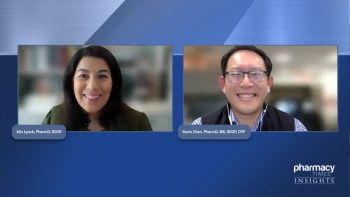
Excluding Differential Diagnoses: MDS vs AML
Robert Mancini, PharmD, BCOP, FHOPA, highlights differentiating diagnoses similar to myelodysplastic syndrome and discusses the International Prognostic Scoring System (IPSS).
Episodes in this series

Ryan Haumschild, PharmD, MS, MBA: I do want to talk a little bit about excluding differential diagnosis. We know with myelodysplastic syndrome [MDS] it could progress to AML [acute myeloid leukemia]. So, Dr Mahmoudjafari, I’m curious of your thoughts. How do you exclude differential diagnoses, such as AML, in your practice?
Zahra Mahmoudjafari, PharmD, BCOP, DPLA: Absolutely. It’s funny for those of us who’ve been in practice for a little while, throughout the years per se, but the division between MDS and AML is a continual area of debate. The original the FAB [French/American/British] definition of MDS including patients with up to 30% of blasts but then in 2001, [the World Health Organization] reduced that upper limit of loss percentage for MDS to 19% rather than the previous cutoff of 29%. Again, in 2008, we know that some patients with AML and myelodysplasia really didn’t change it. You have 20% to 29% myeloblasts that may behave in NEM that are similar in MDS and AML. So, I would say it’s important to note that it shouldn’t just depend on the blast counts. There are some distinct disease curves characteristic with MDS as compared to AML that we’re certainly becoming more accustomed to. For example, patients with FLT3 or NPM1 mutations are more likely to have AML and MDS as are the translocation (15;17), translocation (8;21), or inversion 16, now classified as AML regardless of other features. Additionally, we must consider age, other patient risk factors, cytogenetic comorbidities, performance status, and then of course the patient’s own treatment goals when deciding how we’ll treat. So long story short, it’s a little complicated.
Ryan Haumschild, PharmD, MS, MBA: Well, it is complicated, but I thought you did a great job of breaking it down for our viewing audience and really focusing on the translocation and other differential diagnosis. This really ensures that we’re having a proper diagnosis because I think, at the end of the day, to your point, the better we can identify and classify a patient, the better we can treat them. Some of that has to do with prognostic factors. So, Dr Mancini, if you could, I’d really like to delve into prognostic factors a little bit more. Please discuss the international prognostic scoring system, IPSS, and the revised IPSS-R and how it’s utilized for prognosis and what factors affect prognosis. Also, the different treatment options that we have for these patients.
Robert Mancini, PharmD, BCOP, FHOPA: Absolutely. Dr Mahmoudjafari mentioned that there are more factors than just blast counts that go into defining risk factors for these patients and therefore also treatment options. If you look at the IPSS score, we use the revised IPSS score now, but there is 5 factors that play into how you determine that. You look at each of these factors and then score them on a score from 0 to 4 for each of those. Some of them have all four groups. Some of them have different percentages or points that go into that. The first thing is cytogenetics. I think Dr Mahmoudjafari did a good job outlining a lot of what that high-risk cytogenetics are. You’ll classify these patients based on either very good, good, intermediate, poor, or very poor cytogenetics. Generally something like a deletion 11q or minus Y is going to be a single, very good cytogenetics so you don’t have issues with that adding to your risk factors.
On the flip side of that, you go to something like derivatives or double (cytogenic abnormality) of 7/7q type of abnormalities or patients with complex cytogenetics, and they have 3 or more abnormalities. That puts them in the poor or very poor risk cytogenetics group. That’s just1category. That’s the first one, cytogenetics. Then bone marrow blasts do play into that. Obviously, more blasts would suggest higher risk disease and therefore that plays in. From there, you look at your lineages. So, hemoglobin, platelet, and ANC [absolute neutrophil count], depending on the degree of suppression of those individual cell lines. Those each again get factored in to the overall score. You look at those 5 factors and say these patients are going to get scores for each of those categories and then we’re going to create a risk category. There are 5 risk categories. There’s very low risk, low risk, intermediate risk, high risk, and very high risk. Very low and low are pretty straightforward in terms of how we treat those, mostly symptomatic. Intermediate is hard. It’s questionable. You must look at some other factors in determining how we are going to treat those patients. Patients with high or very high risk are going to look at more aggressive treatments and that’s where potentially chemotherapy or stem cell transplant might play in. One of the things we also know is that these patients have an increased risk of transformation to AML and so as their risk factor gets higher, their risk score gets higher, and the median overall survival drops precipitously. Median overall survival for a very low risk category would be about 8 to 9 years, whereas someone with very high would be less than a year. The risk for developing AML increases greatly over time. So, all those things factor into prognostic scoring and how we would potentially treat these patients.
Transcript edited for clarity.
Newsletter
Stay informed on drug updates, treatment guidelines, and pharmacy practice trends—subscribe to Pharmacy Times for weekly clinical insights.











































































































































































































